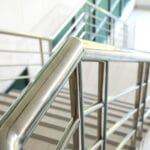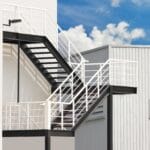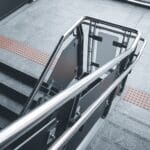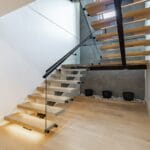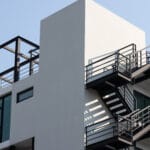Introduction
Choosing the material for an outdoor staircase is a foundational decision that influences its safety, appearance, and longevity. Among the available options, stainless steel stands out as a high-end, durable solution suited to harsh weather conditions. Corrosion-resistant, attractive, and low-maintenance, it is particularly suitable for residential, commercial, and institutional projects.
This article takes an in-depth look at the advantages of stainless steel, comparisons with other steels, proper maintenance practices, and professional recommendations to ensure the durability of your outdoor stairs.
Key Summary
| Theme | Key Points |
| Why choose stainless steel | Corrosion-resistant, attractive, low maintenance, ideal for humid climates and coastal areas |
| Comparison with other steels | Stainless: longevity and prestige; Corten: natural patina; Galvanized: economical solution |
| Average service life | Up to 25 years or more with proper maintenance |
| Recommended maintenance | Annual cleaning, semi-annual visual inspection, anti-rust paint every 5 years |
| Key durability factors | Material quality, appropriate design, professional installation, preventive maintenance |
| Materials in coastal areas | 316 stainless recommended; alternatives: aluminum, hot-dip galvanized steel |
| Importance of expertise | Installation by a qualified professional, warranties and insurance |
| Costs | Regular maintenance reduces long-term replacement costs |
| Practical tips | Soap-and-water cleaning, anti-rust paint, regular inspections |
The importance of choosing the right steel for outdoor stairs
Stainless steel is known for its robustness and exceptional resistance to the elements. Unlike ordinary steel, it contains chromium that forms a protective layer against corrosion. However, not all steels are equal: choosing the right alloy (304, 316, or galvanized) directly influences the performance and durability of the staircase. For Metanox, which specializes in custom metal fabrication, guiding clients to the right material is integral to its quality mission.
Why is stainless steel preferable?
Stainless steel is considered the premium material for outdoor stairs.
- Corrosion resistance: essential for humid, snowy, or coastal areas.
- Low maintenance: fewer treatments required compared to painted or galvanized steel.
- Modern aesthetics: its shine and clean lines enhance architectural design.
- Long-term savings: even if the initial cost is higher, its durability reduces replacement costs.
Working with a specialized manufacturer like Metanox provides custom stainless solutions that combine performance and elegance.
Comparison of steel types: stainless, Corten, galvanized
There are several alternatives to stainless steel. Here is a comparison:
| Type of steel | Advantages | Disadvantages | Approximate service life |
| Stainless (304/316) | Corrosion-resistant, attractive, minimal maintenance | Higher initial cost | 25 years and up |
| Corten | Protective natural patina, rustic look | Requires a dry environment to age well | 10–20 years |
| Galvanized | Economical, good anti-corrosion protection | Periodic maintenance required, limited aesthetics | 20–50 years |
Durability of outdoor stainless steel stairs
A well-designed, properly installed stainless steel staircase can withstand decades of heavy use. Longevity depends on:
- the quality of the chosen steel,
- precision in fabrication and installation,
- maintenance frequency.
A well-maintained staircase can easily support a normal load of 200 kg/m², in line with current safety standards. In a residential context, this allows safe family use; in a commercial context, it ensures compliance with standards and customer safety.
How many years can stainless stairs last?
The average service life of a stainless staircase ranges from 25 to 40 years. In coastal or very humid areas, using 316 stainless steel can significantly extend this period. Periodic preventive measures such as cleaning and inspections are essential to achieve this longevity. By comparison, an untreated exterior wooden staircase often needs replacing after 10 to 15 years.
Factors affecting longevity
Several elements influence the durability of a stainless staircase:
- Weather conditions: exposure to salt, sand, acid rain.
- Installation quality: poor welding or insufficient drainage can accelerate corrosion.
- Maintenance: lack of cleaning or periodic checks increases the risk of degradation.
In short, even the best steel requires rigorous installation and minimal follow-up to deliver on its promise.
Maintaining your stainless steel stairs to ensure durability
Simple but regular maintenance preserves appearance and strength. Three key actions:
- Annual cleaning with water and mild soap.
- Semi-annual visual inspection to spot cracks, loose bolts, or signs of rust.
- Application of anti-rust paint or a protective treatment every 5 years.
These actions prevent major repairs and protect your investment. In an institutional environment, these steps are often part of preventive maintenance plans.
Signs of degradation to watch for
- Localized rust spots
- Cracks in welds
- Peeling paint
- Structural deformation
- Loose bolts or fasteners
These signs should be considered early indicators. The sooner an issue is corrected, the lower the financial and safety impact.
Why is a semi-annual inspection crucial?
Frequent inspections allow early problem detection. A crack addressed immediately costs far less to fix than advanced corrosion requiring partial staircase replacement. For institutional or commercial projects, these inspections may also be required by regulation, reinforcing their relevance. They are also useful for maintaining property value and reassuring occupants.
Comparison of materials for stairs in coastal areas
By the sea, salty air accelerates corrosion. Here is a comparison for this context:
| Material | Corrosion resistance | Durability | Cost |
| 316 stainless | Excellent | 30–40 years | High |
| Aluminum | Good | 15–25 years | Medium |
| Galvanized steel | Adequate, but maintenance required | 20–30 years | More affordable |
316 stainless remains the optimal choice, but for a limited budget, aluminum or galvanized steel may be considered, provided more frequent maintenance is accepted. In high-end projects or those with heavy traffic, 316 stainless almost always proves the most cost-effective long-term solution.
Professional recommendations for installation and maintenance
Hiring a qualified professional is crucial:
- To ensure compliance with safety standards.
- To achieve durable, defect-free installation.
- To obtain personalized maintenance advice.
A professional can also recommend the best surface treatments for the environment. At Metanox, each project is custom-designed to optimize strength, aesthetics, and resistance.
Warranties and insurance
Before purchasing, it is recommended to check:
- Manufacturer warranties: these often cover manufacturing and material defects.
- Insurance: useful to cover accidental damage or damage caused by natural disasters.
These protections add welcome peace of mind. They are particularly relevant for businesses or institutions, where civil liability may be engaged in the event of an accident related to a defective staircase.
Costs associated with maintenance and replacement
Total cost depends on the material, size, and design of the staircase. A well-maintained stainless staircase reduces the need for replacement, making it more economical in the long term.
How to keep maintenance costs low?
- Regular cleaning and inspections.
- Application of anti-rust paint as recommended.
- Prevention rather than repair.
These simple practices extend service life while reducing expenses.
The financial impact of replacement
A full replacement is a major investment. But by opting for stainless and rigorous maintenance, service life is extended, thereby reducing the long-term financial burden. In addition, a well-maintained staircase helps maintain a property’s aesthetic and functional value.
Practical tips to extend the life of your stairs
- Effective cleaning: favor water and mild soap; avoid abrasive products.
- Application of anti-rust paint: about every 5 years, with proper surface preparation.
- Proactive monitoring: a small defect corrected quickly avoids major repairs.
Adding a documented maintenance plan, like the one Metanox can offer its clients, makes follow-up easier and ensures nothing is overlooked.
Conclusion
Outdoor stainless steel stairs combine strength, aesthetics, and durability. Their maintenance is relatively simple and can extend their service life well beyond two decades. Compared to other materials, they are a strategic choice for any residential or commercial project.
If you are considering installing an outdoor metal staircase, contact the Metanox team. With their expertise in custom design and fabrication, you will benefit from a solution that is safe, durable, and perfectly suited to your needs. Metanox is your trusted partner for turning your metal projects into reality.



